Published by admin on 24 Jul 2009 at 12:46 pm
Flight’s Far Flingers by C.R. Learn
Flight’s Far Flingers
By C. R. Learn
Bow and Arrow Magazine March – April. 1968
The flight archer is one who has no target at which to shoot. He lofts his arrow into the air at the prescribed angle of forty-three degrees and is only concerned with how far that shaft will fly down the course. They have no six-gold ring, no spot and no sight. To many, flight perhaps is one of the most different types of archery and they see no earthly reason for shoot it. Those who have tried it cannot stay away from the flight course to see if they can’t better that last shot or perhaps set a new mark themselves. It becomes a competetion with yourself.
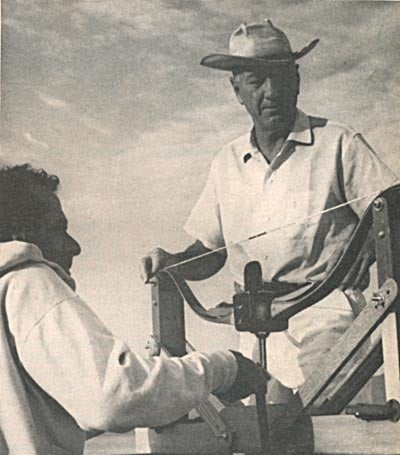
The one thing sought by all is perfection. The best tuned bow, the cleanest release, the best balanced arrow and the proper angle perhaps will bring the archer the coveted distance he is seeking. It does require one more important ingrediant and that is strength. The bows used in flight may vary from a fifty-pounder or under to asone is capable of pulling. If you care to see a hundred-pound or better hand bow, attend the next flight meet and test your strength.
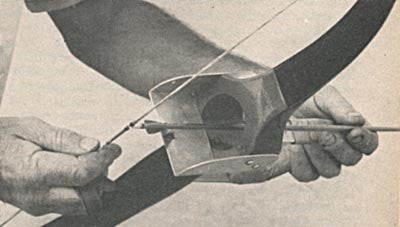
There have been many articles written about the fabulous distances shot by the Turks, but we are concerned with the present. The first thought that usually comes to the fore when flight is mentioned is that it is an expensice hobby, since most bows are broken in just a few shots. This perhaps was true of old self yew bows and there still is a bow broken occasionally, but when a flight bow manufactured will guarantee his product for one full year unconditionally, that speaks for itself. There may be a new flight bow design or a sight change in one and these are the ones most often seen exploding when shot.
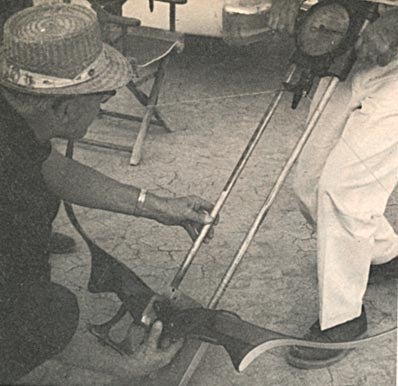
The bows used for flight shooting are good for several years and the usual reason for purchasing another is to obtain a different poudage to enter another event. Unlike target or field the events in flight are the same in every meet. They have five classes: 50, 65, 80-pound and an unlimited category in which one can shoot any draw weight from fifty or below to over one hundred pounds. The final class is the footbow, but another may be added in the crossbow, since many enthusiasts are experimenting with this method of casting a shaft. They are also thinking of adding target flight and hunter flight events, using regulationbroadheads. Each of the current classes is divided into two groups: amateur and prfessional. This means that the first-time-out flight shooter isn’t competing with the seasoned por for records.
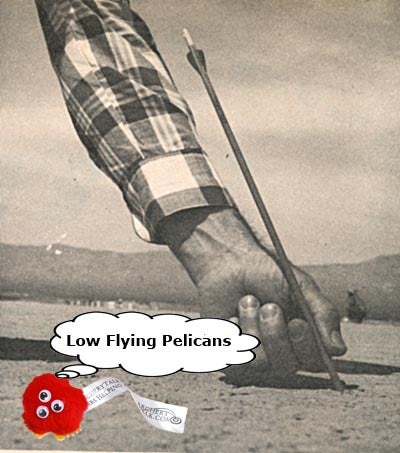
Perhaps the best method of approaching flight archery is to compare the equipment with the usual tackle. The shaft used seldom is longer than twenty inches and closer to eighteen inches. The bows may have corresponding poundages, but the design is different. The flight bow usually is about forty-two inches overall in length and differs drastically from hunter or target equipment in several ways. The length is less than even the shortest practical hunter. Limb design is the same with fiberglass back and face with hardrock maple or other hardwood laminates between glass.
The handle section of the bow may or may not have a handle. The older style had a handle similar to standard bows before Harry Drake, a leading flight archer and the only manufacturer to make and sell strictly flight equipment, began experimenting. First he went from the conventional grip to using the heel of the hand on the face of the bow. This prevented torque but limited the weight, since it was hard to pull anything heavier than sixty five pounds. His present handle system is fastened to the back of the bow by means of an aluminum handle extension. In this extension is a standard type bow grip of hardwood. This gets the left arm of the right-handed archer out in front of the bow and allows him to use his shoulder muscles to more advantage than with pervious methods.
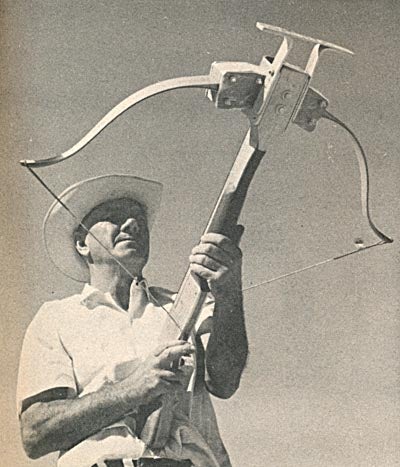
The first thing about the flight bow attract attention, other than the short length and the extended handle, is the full center-shot design. This doesn’t mean the bow is cut in sight window past center as with the conventional style. There is a hole right in the center of the handle between the limbs, called a keyhole. Behind the center hole is an extension shelf on which the arrow is drawn and released. This allows the flight archer to shoot a shorter shaft and still use his full draw length of twenty-eight inches and want to shoot a twenty inch shaft, your handle will extend several inches in front of thw bow and the overdraw shelf will extend several inches behind to allow this short shaft to be drawn to normal length.
Limbs of a flight bow are tuned finely for balance and for tension to obtain the maximum from the bow design. They are recurved but the amount of the laminate in the wood core, the taper of the laminate if any, and the thickness of the fiberglass back and faced are weighed and calculated closely.
An example concerns a recent test by Drake on the curvature of the edges of a bow under stress. He noticed that when a bow does break or the glass let’s go on a bow under stress, it usually is at the edges. This meant that the edges of the bow were moving, more and getting more stress than the center of the glass in the bow limb. He made a test bow with the face glass convexed to the center and the back glass concaved to allow for this problem.
Bowstrings usually are made the same as any other, except for the balance of the string as to the center serving. The amount of serving to come down from the tip end loops and the proper number of strands are constantly being checked and tested by each flight enthusiast. When Easton introduced the new Dacron Super B and wanted to give it roughest ppossible test, they called Harry Drake to use the bowstring in his 180-pound foot bow. He confirmed their tests that it was far stronger than any other string materials.
The shaft that is shot in flight is like no other. The crossbow bolt might come close but not very. These little chunks of wood are works of art made of Port Orford cedar and often footed with purpleheart or some other hardwood, but the most popular material used now is Forgewood.
Drake orders full length shafts from Bill Sweetland of Forgewood Products. These then are sent to Riley Denton, who turns them down on the tip and adds a small brass point. These shafts are barreled to the tip and left normal toward rock end. By standards he has set up over the years, Drake tapers the front half to his specs, then tapers the nock section. The length of his flight shafts varies from 18-1/2 to 18-7/16 inches. For nocks, he has perfected a method of laminating four pieces of fiberglass to the tapered shaft. This gives an arrow a much stronger nock to withstand the tremendous pressures of heavy bows.
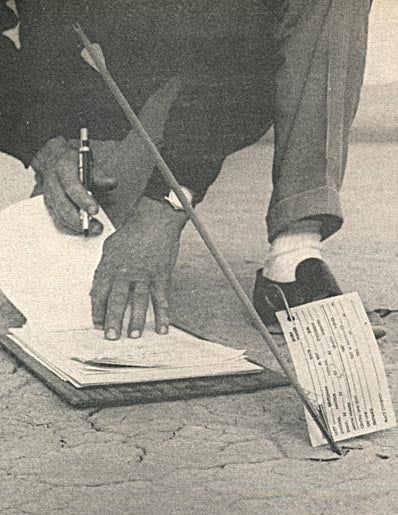
The last step is the fletch. I fyou look hard you will see it by the rock: three small pieces of plastic vane mounted on the shaft. We usually have our cock feather off the side of the bow to obtain clearance. In the center-shot bow there is no problem of side clearance, so the cock feather is mounted on top or parrallel with the nock cut for the string, the other two fletch on each side, leaving the bottom completely clear to move over the arrow rest on the overdraw shelf.
The bow is picked up in the left hand, if you are right-handed. The shaft is nocked onto the string, which is built up to hold the tiny nock on with no pressure, and all that is left is to draw and let fly.
But how does one draw a bow that has no archer’s paradox. This, simplified, is bending of the arrow around the side of the bow, hence spine problems and erratic flight. We have nothing for the arrow to bend around, since it is sitting on its toothbrush rest in the middle of the bow!
If you use the regular three-finger, two or one-finger release, the flight shaft will slam into the side of the bow and literally disinegrate.
The answer is the double flipper. This is simply a piece of leather that is brought around the little finger at the mid-point of the flipper, the other ends are out in front. The end on the left side is brought around the string and held while the end on the right is placed over and around the left half and the string. When pressed together between the thumb and first finger, this offers one of the cleanest releases I’ve seen. The bow is drawn with the leather double flipper by the pressure of the thumb and the first finger, with some help of the the loop placed around the little finger at the back of the hand.
The accpted angle to release your shaft is forty-three degrees. Some may like forty-three but it does become difficult to split a few degrees while drawing a sixty-five-pound bow.
There is no anchor point in flight shooting. When the archer see’s his shaft reach the back of the arrow rest, he relaxes while drawing and the arrow is on its way. This gives the best possible trajectory to the shaft.
Flight is used by many archers to determine which bow is the fastest. Take your favorite hunting bow and a friend with his into a wide, open field. Both should shoot in the same direction to make the testvalid. Shoot at the prescribed angle of forty-three degrees with your choice of shafts, but of the same weight and length. Launch at least six shafts for an average and you may be surprised at the results. The faster bow will shoot the longer distance.
The California State Flight Shoot is held at Ivanpah Dry Lake each summer. This lake bed stretches for miles with a firm soil just just made for plopping arrows around great distances. Harry Drake has been there for several days lining up the measuring stakes and measuring distances. Sunday morning found several devotees of the sport tuning up and weighing in equipment. Each bow is weighed on a certified scale and the weight recorded at the draw length. Each arrow to be shot in that event or class is numbered and each contestant shoots six arrows in each class entered. These shafts usually are weighed by the owner and have the individual weight marked on the shaft, his number and also his name is written on each shaft to be shot.
Some will shoot all six shafts in swift succession and retire from the line. Others may shoot, relax, then prepare the next shot. After all contestants have shot the allotted shafts they find and tag all arrows.
When a shaft is found, the name of the archer is called out and when the most distant shaft has been found of those shot by the contestant, it is marked with a metal stake with his name, arrow number, weight and the event. When all shafts have been found, marked and accounted for, the archers return to the shooting line and prepare for the next class.
Mornings are usually the best time, since there is little windand the heat hasn’t started thermal air currents moving. Contestants shoot with any wind to their backs to give the shaft the best advantage.
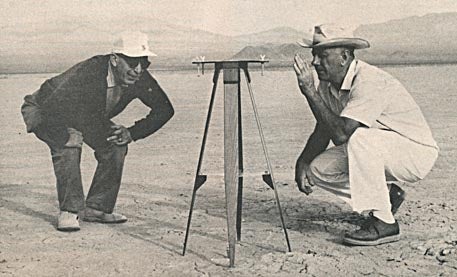
Perhaps the most unique the most unique event to watch is the foot bow, working the bows in one hundred-pound range or better. The feet are placed on the face of the bow with small sheets of lead over the arch to protect the footfrom the string. There usually are rubber bands stretched at these points to give the foot something which to grip thw bow. The archer sets his arrow on the rest with the mid-nock on the string, then rocks back after placing a two-handed double flipper on the string. This is nothing more than two double flippers, one in each hand, to help pull these heavy bows. With the arrow on thw string and the flippers wrapped properly, the archer rolls on his back and elevates his feet on te bow. When he has attained the needed draw, the arrow is loosed. The bow flies up in the air and usually lands on the archer. It is amusing to watch but Drake has shot well over 1,000 yards using this technique and a 180-pound bow.
Two new events have been encorporated by the California Flighters. George Alavekiu of San Fransisco shot a bolt from his 135-pound crossbow to a new record distance of 1148 yards, two inches. The previous record is 660 yards, nine inches. The crossbow was of Alavekiu’s own design. He also makes his own flight bows. Several archers competed in the broadhead event.
Dr. Charles Grayson of Sacremento remarked that he had hunted in Africa, Mexico, Canada and th U.S. and had shot target and field, but feels that flight is the most exacting and inteteresting phase of archery.
Each time the flight shooters get toether it is to better the excisting records in each class, then get tuned up again to beat their own records. They now are shooting some of the shafts over a half mile and that is moving a piece of wood.
Unless otherwise indicated, all materials on these pages are copyrighted by Bow and Arrow Magazine and Archerytalk.com. All rights reserved. No part of these pages, either text or image may be used for any purpose other than personal use. Therefore, reproduction, modification, storage in a retrieval system or retransmission, in any form or by any means, electronic, mechanical or otherwise, for reasons other than personal use, is strictly prohibited without prior written permission.
Leave a Reply
You must be logged in to post a comment.


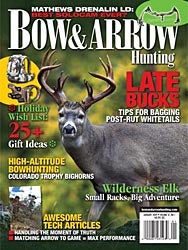
 Your Privacy Choices
Your Privacy Choices